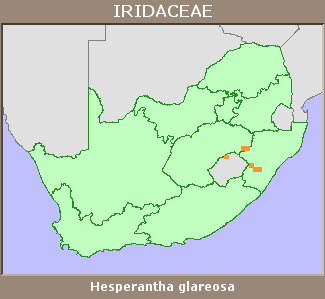|
Scientific Name | Hesperantha glareosa Hilliard & B.L.Burtt |
Higher Classification | Monocotyledons |
Family | IRIDACEAE |
National Status |
Status and Criteria | Least Concern |
Assessment Date | 2021/05/31 |
Assessor(s) | W. Foden, L. Potter & T. Patel |
Justification | This species is restricted to the central Drakensberg, extent of occurrence (EOO) of 6300 km²and is not threatened. It does not seem to face any major threats, and is therefore listed as Least Concern. |
Distribution |
Endemism | Not endemic to South Africa |
Provincial distribution | Free State, KwaZulu-Natal |
Range | This species occurs in central Drakensberg in Lesotho and Free State and KwaZulu-Natal in South Africa. It possibly also extends north to southern Mpumalanga. |
Habitat and Ecology |
Major system | Terrestrial |
Major habitats | Grassland |
Description | It grows in damp turf and wet, rocky pavement. |
Threats |
| There are no threats affecting this species. |
Population |
It is locally common within its habitat. The population trend is unknown, however, it is not suspected to be declining.
|
Population trend | Unknown |
Assessment History |
Taxon assessed |
Status and Criteria |
Citation/Red List version | | Hesperantha glareosa Hilliard & B.L.Burtt | Least Concern | Raimondo et al. (2009) | |
Bibliography |
Goldblatt, P. and Manning, J.C. 2020. Iridaceae of southern Africa. Strelitzia 42. South African National Biodiversity Institute, Pretoria.
Raimondo, D., von Staden, L., Foden, W., Victor, J.E., Helme, N.A., Turner, R.C., Kamundi, D.A. and Manyama, P.A. 2009. Red List of South African Plants. Strelitzia 25. South African National Biodiversity Institute, Pretoria.
|
Citation |
| Foden, W., Potter, L. & Patel, T. 2021. Hesperantha glareosa Hilliard & B.L.Burtt. National Assessment: Red List of South African Plants version 2024.1. Accessed on 2025/12/13 |
 Comment on this assessment
Comment on this assessment


